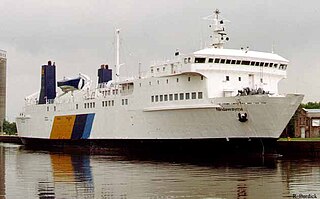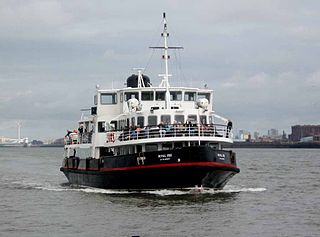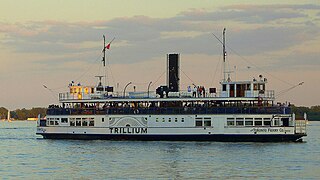
The Mersey Ferry is a ferry service operating on the River Mersey in northwest England, between Liverpool to the east and Birkenhead and Wallasey on the Wirral Peninsula to the west. Ferries have been used on this route since at least the 12th century and continue to be popular for both local people and visitors.

TS Queen Mary is a Clyde steamer launched in 1933 at the William Denny shipyard, Dumbarton, for Williamson-Buchanan Steamers. She is currently being restored as a museum ship, in Glasgow.

Moby Orli is a cruiseferry owned by Moby SPA. Until September 2010, she was known as Pride of Bilbao, operated by P&O Ferries on their Portsmouth–Bilbao route. The vessel was built in 1986 as Olympia at the Wärtsilä Perno Shipyard in Turku, Finland for Rederi AB Slite, Sweden for use in Viking Line traffic. She was sold by Irish Continental Group to St. Peter Line in December 2010 and renamed Princess Anastasia and operated on the Saint Petersburg – Helsinki – Stockholm – Tallinn route. In 2022 she was withdrawn because of the conflict in Ukraine, transferred to Moby Lines and sailed to Messina for refurbishment. She was set to return to service in the Mediterranean.

The MV Manx Viking / Nindawayma was a passenger, truck and car ferry, whose last active service was on Lake Huron, operated by the Owen Sound Transportation Company; under contract to the Ontario Ministry of Transportation. In Canadian service she served the Highway 6 route between Tobermory and South Baymouth, Manitoulin Island from 1989 to 1992 alongside the MS Chi-Cheemaun.

MV Royal Daffodil is a former ferry based on the River Mersey, England. From launch until a major refit in 1998 /1999, she was named MV Overchurch, she began service for Birkenhead Corporation Ferries in 1962 and was in regular service on the river until her withdrawal in December 2012. Despite her extensive re-build in 1999, the ship still retains a similar profile to that of her original design. After her withdrawal, the vessel remained idle since her dry docking and survey in January 2013. In April 2019 a new home was confirmed for the ship in the form of a new floating leisure attraction, in Liverpool's Canning Dock.

The MV Vacationland is a Canadian RORO ferry that operated across the Northumberland Strait between the ports of Cape Tormentine, New Brunswick and Port Borden, Prince Edward Island.

Blue Wave Harmony is a ferry formerly known as MS Sea Anatolia and originally launched in 1991 for P&O as European Seaway. From Spring 2023 it was owned by Blue Wave Corporation.

MS King Seaways is a cruiseferry operated and owned by the Danish shipping company DFDS Seaways on a route connecting North Shields, effectively the port of Newcastle upon Tyne,, England to IJmuiden in the Netherlands. She was built in 1987 as MS Nils Holgersson by Seebeckwerft, Bremerhaven, West Germany for TT-Line. Between 1993 and 2006 the ship was named MV Val de Loire, owned by Brittany Ferries and used on traffic across the English Channel. A DFDS vessel since 2006, she was originally named MS King of Scandinavia, before being given her current name in 2011.

The MV Royal Iris of the Mersey is a Mersey Ferry in operation on the River Mersey, England. From launch in Devon in 1959 until a major refurbishment in 2001, she was named MV Mountwood.

The MS Finbo Cargo is a roll-on/roll-off passenger ferry that was previously called the European Endeavour which was owned and operated by P&O Ferries until May 2019. Eckerö Line purchased the ship from P&O in 2019 and is expected to take delivery in June 2019 and renamed her MS Finbo Cargo.

MS A Nepita is a fast ropax ferry for Corsica Linea. The ferry was refurbished in Gdańsk, Poland for her new service and was returned to her original design before her SeaFrance career and looks identical to her sisters Stena Superfast VII & VIII. Before November 2014 she operated between Dover and Calais for DFDS Seaways France and between 2008 and 2012 for SeaFrance.

MS Spirit of Tasmania II is a roll-on/roll-off ferry operated by TT-Line between Geelong and Devonport in Australia. Built in 1998 by Kvaerner Masa-Yards at Turku New Shipyard in Finland for Superfast Ferries as MS Superfast III, since 2002 she has sailed for TT-Line as MS Spirit of Tasmania II.

MS Stena Europe is a ferry owned by Stena Line which operated on its Fishguard—Rosslare route until withdrawn from that service in July 2023.

MS GNV Antares, originally the MS Norsun and then MS Pride of Bruges, is a ship operated by Grandi Navi Veloci.

MV Pioneer is a stern / side loading ferry built in 1974, in service for 29 years covering nearly all of Caledonian MacBrayne's routes. She now serves the islands of São Tomé and Príncipe in the Gulf of Guinea and was chartered to rescue Liberian refugees.
Ceuta was a 2,719 GRT cargo ship which was built in 1929 for the Oldenburg-Portugiesische Dampfschiffs-Reederei. She was sunk during an air raid in 1943, but later raised, repaired and returned to service. She was seized as a war prize in 1945, passed to the British Ministry of War Transport (MoWT) and renamed Empire Camel.
Scillonian was a passenger ferry built for the Isles of Scilly Steamship Company in 1955 by John I. Thornycroft & Company of Woolston, Southampton. She was designed to carry 500 passengers and cargo between Penzance, Cornwall, to the offshore Isles of Scilly.

ST Cervia was built in 1946 as a seagoing tug for use as a fleet auxiliary by Alexandra Hall & Company Ltd of Aberdeen, Scotland. Today she is a floating Museum still undergoing restoration in Ramsgate, Kent.

The MV Bremerhaven was a cruise ship originally built in Germany in 1960 for ferry services. She served under different guises and owners until she was scrapped in 2008.

Trillium is a side wheeler ferry operated by the City of Toronto Parks, Forestry and Recreation, in Toronto, Ontario, Canada. Now 114 years old, she is one of several Toronto Island ferries operating between the Jack Layton Ferry Terminal at Bay Street and Queens Quay and three landing points on the Toronto Islands. She is the last sidewheel-propelled vessel on the Great Lakes.






















